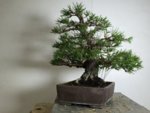No, he’s saying I presented evidence to support my position that trees with forward leaning apexes look good.
You haven’t supported your position with trees that lean backwards with anything other than words.
Furthermore, I showed that trees that lean forward don’t look like they lean forward in photographs taken from the front. It’s not until you get a side shot that the forward lean becomes noticeable.
I maintain that most, if not all, of the great trees you see in photographs have a pronounced forward lean. You just don’t see it in a photograph. Which is why I suggested you go to shows to see it in real life.
@coh even said that most, if not all the trees at the National Show have a forward lean. Now, this is a show of some 300 trees and about 150 individual bonsai artists from all over the US. And virtually every one has the apex moving forward. Do you think they all get together and plan it out? Or could it be each styles his tree to make it look the very best? I think the latter. And moving the apex forward is a choice each and every one makes! Why, it makes the tree look good because of the forced perspective it imparts.
Now, you have asked “why?”. The answer is simple: it makes the tree look good! If it didn’t, then the majority of trees would not lean forward. They’d move every which way. But the truth is, the forward lean of the apex “tricks the eye”. It aids in making the tree look shorter. Which means that more branches can be packed in (coming off the trunk) because the trunk is actually longer than it appears to be. The tree may be 24 inches tall. But the trunk may actually be 28 inches long! Because when you lean it forward, it lowers. So, you can use that extra trunk to get more branches. And in the angle of lean is greater up at the apex, the distance between the branches VISUALLY appears to be shorter because they are more behind each other rather than above each other.
The concept is “forced perspective”. Look it up in how it’s used in art.
Stacey Allen Muse started a thread on the concept about 4 or 5 years ago. Talking about vanishing points, horizons, etc.
Now, I’m a reasonable guy. I’ll show you a good tree where the apex does NOT move forward:
View attachment 225533
It’s a formal upright JBP. And the tree grows straight up. No forward lean. Because the definition of a FU state it should be straight up. This (and broom) are the exceptions to the rule of forward moving apexes. You hardly ever see true FUs because it’s hard to get one that will still look good while confirming to the style’s rules.
This tree:
View attachment 225534
Is it a formal upright? It certainly LOOKS like one, doesn’t it? But, no, it can’t be one. It has a very pronounced forward lean that you can’t see! So, it an informal upright.
Here Is a side shot taken of the tree a couple years ago:
View attachment 225536
You can see the trunk is definitely curved towards the front which is on the left from this angle. You would never know just by looking at the front.
So...
The pictures you see of great trees don’t show you the forward lean. Believe me, it’s there.









